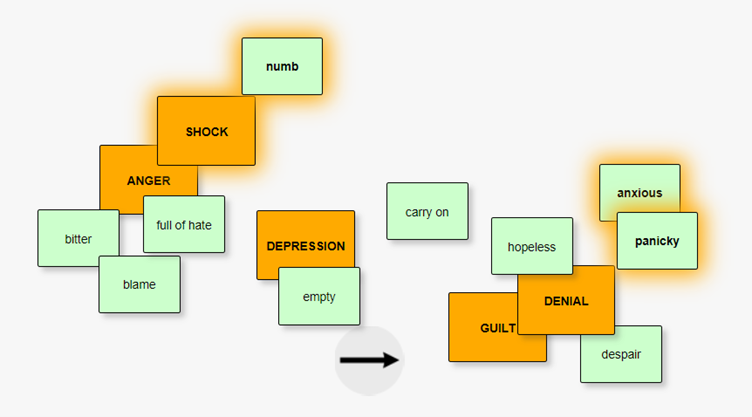Emotional Chaos Theory is an explanation of how personal insights gained by mapping the complex emotional states that people may experience during times of change, disappointment or hurt can lead to dramatic improvements in their sense of personal identity, self-respect, and wellbeing. This transformative learning process of re-engagement with life emerges as a post-traumatic growth of inner strength and more decisive movement, the person having previously been feeling stuck in distress, tension or confusion with poor sleep patterns. Repetitive features of the mapped emotional patterns of these stressed states can be consistently associated with the diagnostic criteria for common mental illnesses and socially disruptive behaviour. A feedback learning intervention can, however, prevent progression from stress states to mental illness and social disruption.
The unique difference between a chaos theory of a person’s emotional experience, and the current cognitive psychology model of that same experience, is the concept of pattern.
A therapeutic psychologist trained in the experimental model will tend to think in a linear way in terms of stimulus-response. There is, in this person’s rationalising mind, an identifiable cause of an emotion and a measurable effect of the emotion on behaviour. What happens in the middle, what the emotion is, is less important than calculating the relationship between the measured input and the measured output. It is an empirical ‘informational model’ that places the experimenter as an observer of the informational transfer of order or disorder. The priority, in this rationalisation of life, is an empirical ‘proof’ of relational connection, as contrasted with a random disconnection. Proof of connection means that it can be predictably manipulated empirically. Relationships, in this model, can be described in mathematical algorithms that calculate the power needed to manipulate them.
An ecological psychologist, by way of contrast, has a different starting place to this type of manipulative empiricism. This person will tend to think in New Science terms of being part of the experiment, embedded intra-actively in the living relational dynamics of multiple natural and living systems of interaction. Feedback loops and cybernetic influences among these multi-layered systems are so complex that the notion of acting on some ‘thing’ becomes difficult to sustain. Karen Barad’s term intra-active is the best way to describe the mental state of an ecological psychologist thinking about emotion.
To an experimentally trained psychologist, the words that describe emotions, for example anger or depression, are descriptive summaries for transitional living states and feelings that are impenetrable to the rational empirical mind. They describe instead patterns superficial consequences in behaviour – patterns of symptoms. Feelings of emotion arising between a stimulus and its response are side-effects, epiphenomena, which only randomise the cause and effect of rationalised information transfer. Feelings of emotion may therefore be seen as a cause of psychopathology that interferes with a background condition of potential health. It is a dualistic model, the cure for pathological states being further informational input, cognitive behavioural therapy.
To an ecological psychologist, an intra-active conversation with a distressed person is already the start of the mutual learning intervention. The relational dynamic is a synergic informational process in which the transitional states, considered by an experimental psychologist to be impenetrable, can be mapped behaviourally by using the emotion-mapping tools of Emotional Logic (emotion card sorting patterns, and Loss Reaction Worksheet tick patterns). The physical spacing of the card patterns placed intuitively on a table or lap tray has been found empirically to reveal informationally the complex emotional patterns that are shaping each person’s heart-level responsiveness. The ecological psychologist is thus pattern-mapping inner causes of distress, not merely the symptoms. Emotions are ‘real relational dynamics’ at this level, not merely descriptive summaries of an impenetrable but observable process. To an ecological psychologist, the word emotion means a range of dynamic biochemical states of the body’s physiology and social messaging, appearing as facial expressions, body language, tone of voice, and pheromone chemical release in perspiration. These states can be interpreted by others, sometimes more accurately than by the person who is supposed to have preferential insight into their own experience.

Thus, when an experimental psychologist simplifies emotional language by saying someone’s behaviour shows they are angry, an ecological psychologist will not step away from the behaviour for safety to observe it from a distance. An ecologically-present skilled helper will step forwards instead, into an intra-active conversation, resourced additionally with emotion mapping tools and a mental framework to make sense of the revealed patterning of this person’s inner heart in the complexities of their current situation. The ‘anger’ observed behaviourally will be seen from these patterns to be ‘coloured’ by a large dose of Shock perhaps, and maybe a background drift of Depressive Emptiness, with a hint of Guilty Self-questioning peeping in when no-one is looking at the shame that is being hidden, for example. A far richer and deeper and more empathic relationship emerges with these insights, so that the conversation can move on to explore solution-focused action plans, which could transform the pattern of emotions from a stuckness that generates distress, to movements that generate self-efficacy.
E-motion is energy in motion. The synergy of mutual conversational states among intra-active people generates that energy. Mapping complex emotional states enables distressed people to know that they have been ‘heard’. That is the start of stress-reduction and the prevention of mental illness and socially-disruptive behaviour.

